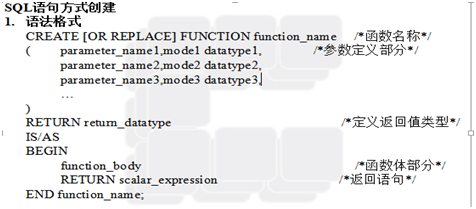Oracle学习笔记之用户自定义函数
自定义函数语法格式:

用户自定义的函数,可以直接在sql语句中直接调用,并且任何一个funciton都必须有返回值,而且该函数声明后,是保存在数据端的,我们随时可以使用;注意:函数只能有一个返回值,如果想返回多个数据,可通过out类型参数将数据传到函数外部;
例如:定义一个函数,该函数根据员工姓名以及部门编号,查找该员工是否在emp中存在,如果存在返回true否则返回false;
createorreplacefunction myFunction(mName invarchar2,mNo innumber)returnbooleanis
flag boolean:=false;
total number;
begin
selectcount(*)into total from emp where emp.ename=mName and emp.deptno=mNo;
if total>0then
flag:=true;
else flag:=false;
endif;
return flag;
end myFunction;
测试:
-- Created on 2017/10/19 by ADMINISTRATOR
declare
f boolean;
begin
f:=myfunction('SMITH',30);
if f then dbms_output.put_line('true');
else dbms_output.put_line('false');
endif;
end;
例如:定义一个函数,该函数根据员工姓名以及部门编号,查找该员工是否在emp中存在,如果存在返回true否则返回false;如果存在该员工,那么就将该条数据拿到函数外面;
createorreplacefunction myFunction(mName invarchar2,mNo innumber,msg out emp%rowType)returnbooleanis
flag boolean:=false;
total number;
begin
selectcount(*)into total from emp where emp.ename=mName and emp.deptno=mNo;
if total>0then
flag:=true;
--将该条数据赋值给msg变量
select emp.*into msg from emp where emp.ename=mName and emp.deptno=mNo;
else flag:=false;
endif;
return flag;
end myFunction;
测试:
declare
f boolean;
msg emp%rowtype;
begin
f:=myfunction('SMITH',20,msg);
if f then dbms_output.put_line('true');
else dbms_output.put_line('false');
endif;
dbms_output.put_line(msg.empno||':'||msg.ename||':'||msg.hiredate);
end;
例如:定义一个函数,该函数根据员工姓名以及部门编号,查找该员工是否在emp中存在,该函数返回值为该条记录;
createorreplacefunction myFunction(mName invarchar2,mNo innumber,msg out emp%rowType)return emp%rowtypeis
flag boolean:=false;
total number;
begin
selectcount(*)into total from emp where emp.ename=mName and emp.deptno=mNo;
if total>0then
flag:=true;
--将该条数据赋值给msg变量
select emp.*into msg from emp where emp.ename=mName and emp.deptno=mNo;
else flag:=false;
endif;
return msg;
end myFunction;
测试:
-- Created on 2017/10/19 by ADMINISTRATOR
declare
msg emp%rowtype;
begin
msg:=myfunction('SMITH',20,msg);
dbms_output.put_line(msg.empno||':'||msg.ename||':'||msg.hiredate);
end;



